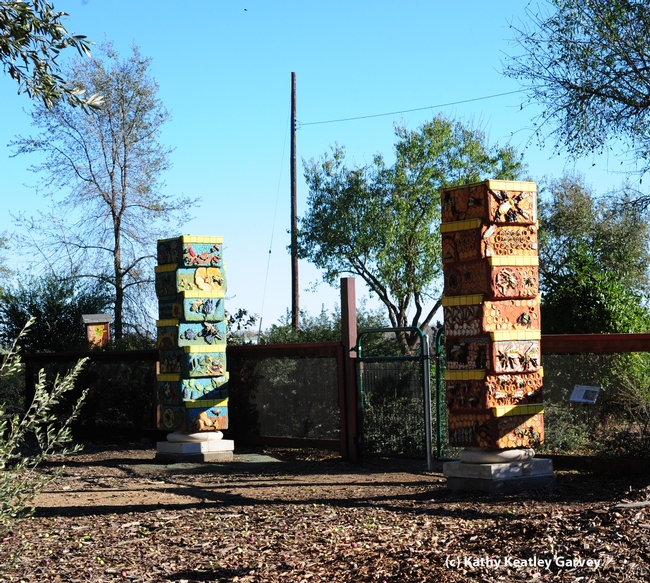
The artists would work on the installation daily, then stop and cover the art, resuming only when weather permitted.
The site: the half-acre Häagen-Dazs Honey Bee Haven, designed as a year-around food resource for bees, to raise public awareness about the plight of bees, and to show visitors what they can plant in their own gardens. Part of the UC Davis Department of Entomology, it's located just a few yards east of the Harry H. Laidlaw Jr. Honey Bee Research Facility on Bee Biology Road, west of the central campus.
For awhile, rain pelted the tarp-covered art. Then the fog rolled in. Not to be outdone, wind tugged at the protective covers, hinting at the beauty beneath.
Finally, the artists finished the installation.
This afternoon, entomologist/artist Diane Ullman, co-director of the UC Davis Art/Science Fusion Program and professor of entomology at UC Davis, unwrapped the two pillars at the front entrance. She also removed the tarps covering the ceramic mosaic-tiled cement planters inside the haven.
Ullman, associate dean in the College of Agricultural and Environmental Sciences, co-founded the Art/Science Fusion Program with noted artist Donna Billick of Davis, a self-described "rock artist." Together they direct the program and teach an Entomology 1 class that does just that--fuses art with science.
Last quarter the students studied bees and then developed the art. For many, it was their first attempt at a major art project. They are not art majors. Their majors include managerial economics, genetics, biological sciences, environmental toxicology and chemistry, and wildlife management.
At the end of the quarter, they stood in front of their classmates and discussed what they learned about bees and the obstacles and rewards. (See photos.) They did a fantastic job!
Andrea Wagner, a graduate student in entomology, served as the teaching assistant for the course and also created some of the art. Lending a welcoming hand in the installation was Mark Rivera of Davis, a professional ceramic mosaic artist, whose work includes the carrot sculpture by the Davis Co-Op.
"We couldn't have done the installation without Mark," Ullman said.
Several years ago, Ent 1 students painted the two towers of bee boxes at the entrance. One tower of seven boxes depicted bees inside the hive, and the other tower, bees outside the hive. Unfortunately, the paint began peeling. Subsequently, Ullman and Billick opted for a more permanent art: mosaic ceramic tiles to cover the 14 boxes. As before, one tower depicts activity inside the hive, and the second tower, activity outside the hive.
UC Davis students also created mosaic ceramic panels for two of the three cement planters inside the garden. (The UC Davis Art/Science Fusion Program had only enough money for two.)
Meanwhile, the garden has never looked better. The state-of-the-art fence that surrounds the garden is the work of Derek Tully, 17, of Davis, who last summer completed the fence as his Eagle Scout project.
The garden, planted in the fall of 2009, is open to the public from dawn to dusk, year around, for self-guided tours.
Beginning next March 1, Christine Casey (cacasey@ucdavis.edu) will begin offering guided tours for $4 per person.
Attached Images:

Beneath these weather-protective tarps: bee-box pillars. (Photo by Kathy Keatley Garvey)

Entomologist/artist Diane Ullman uncovers a pillar. In the foreground, a bee sculpture created by colleague Donna Billick. (Photo by Kathy Keatley Garvey)

Today was a cold, blustery day but the pillars gleamed in the sunlight. (Photo by Kathy Keatley Garvey)

This work, showing the developmental stages of a worker honey bee, is by artist Donna Billick. (Photo by Kathy Keatley Garvey)